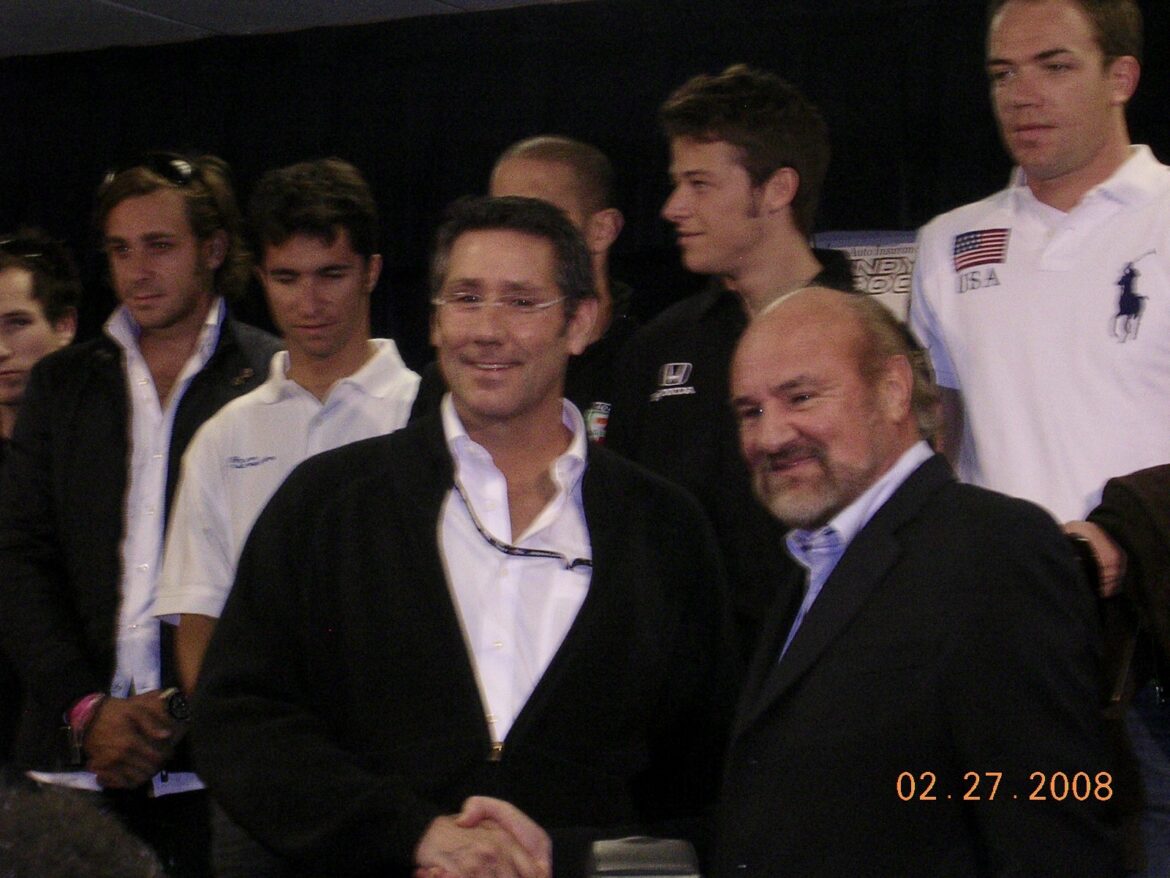Some readers may be aware that my next book project is pretty much a post-war history of Indy car racing in the Hulman-George era.
I set out to write about the modern day “split” between CART/Champ Car and the Indy Racing League from 1996 to 2008. I quickly realized to tell the story of the IRL/CART war, you had to explain the original 1979 USAC/CART split; to understand that conflict (and why it was never totally resolved) requires background about the rear-engine revolution of the 1960s, which leads back to the formation of the United States Auto Club, which leads back to Tony Hulman’s purchase of the Indianapolis Motor Speedway. In that respect, November 14, 1945 – the day Hulman acquired the Speedway from Eddie Rickenbacker and started to build his power base in auto racing – marks the dawn of modern Indy car racing.
Since then, February 22, 2008 is arguably the sport’s most significant day. That’s the day when Tony George, the grandson of Tony Hulman and heir to the IMS throne, and Champ Car World Series co-owner Kevin Kalkhoven finally agreed on a plan to create a single American open-wheel championship.
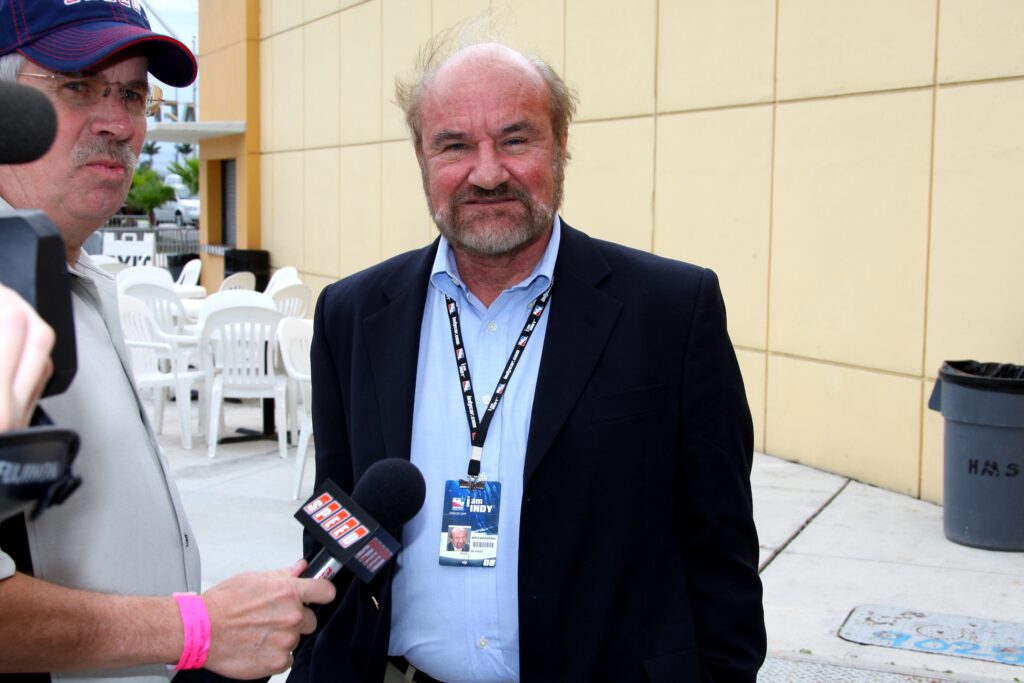
The “merger” or “unification” was more akin to the IRL absorbing key surviving elements of CART, but it was still symbolically significant. It was supposed to provide Indy car racing with the stable platform and traction it needed to turn around fifteen years of crippling in-fighting that prevented the sport from achieving its potential. In that time, NASCAR sped ahead of Indy car and became synonymous for racing in America.
In February 2008, I wrote an “FAQ” about the unification, and how it might affect Indy car racing’s future. It’s interesting to look back on what happened, and how many of my predictions came true.
[Edited version of ESPN.com column follows]
HOMESTEAD, FL – One of the things the unification of American open-wheel racing is supposed to accomplish is eliminate the confusion that resulted from having two competing series over the last twelve years.
With that in mind, let’s get straight to the point and answer a few Frequently Asked Questions about open-wheel racing’s brave new world under the leadership of Tony George and the Indy Racing League.
Q. What actually happened to create this so-called unification?
A: On February 22, the ownership group of Champ Car (chiefly Kevin Kalkhoven and Gerald Forsythe) reached agreement in principle with George for the IRL to acquire and/or merge key elements of the Champ Car World Series into the IndyCar Series. After the 34th annual Toyota Grand Prix of Long Beach on April 20 – which is being billed as a gala send off for the Champ Car formula – the Champ Car World Series will cease to exist and most, if not all Champ Car teams will join the IndyCar Series.
[2020 note: Five Champ Car teams made the jump – Newman/Haas/Lanigan Racing, Dale Coyne Racing, HVM Racing, Conquest Racing, and KV Racing]
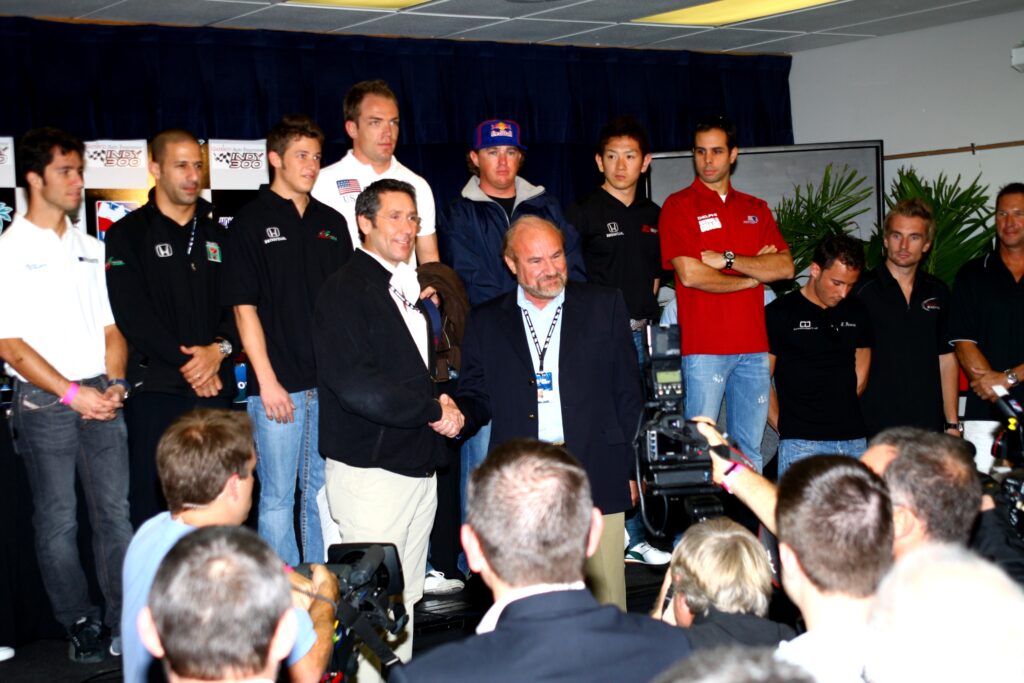
Q: Why is this unification so significant?
A: Because it puts an end to a deeply damaging battle for control of American open-wheel racing that can be traced to the late 1970s. By prevailing over Champ Car, George regained the leadership position that the Indianapolis Motor Speedway Corp. (i.e. the Hulman-George family) lost in 1979 when a group of team owners formed Championship Auto Racing Teams (CART) and took over as the chief sanctioning body of top-level open-wheel racing in the United States. Using the Indianapolis 500 as an anchor, George announced the IRL in 1994, and since 1996, he positioned it as a direct competitor for the open-wheel series operated by CART and later Champ Car. That created confusion and animosity within the fan base and the sponsor community and resulted in an environment in which it was impossible for both series to survive.
[2020 note: Passes the Fact Check test]
Q: What is the fallout from the merger?
A: A couple of teams probably aren’t going to be able to make the transition. Suppliers like Panoz, Hewland and Carl Haas Auto will absorb financial losses. Most of Champ Car’s 50 staff members lost their jobs, with the exception of a skeleton crew being kept on who will operate the Long Beach event. Engine supplier Cosworth USA will lay off nearly 30 people at the end of this week, and eleven of the fourteen events on the Champ Car schedule are affected. Some events will go on with the scheduled support series moved up on the bill, but others, like Portland and Cleveland, have been cancelled outright.
[2020 note: Dale Coyne Racing is the only team from the the 2007 Champ Car series that still competes in Indy car racing. Forsythe Racing never ran another race. Several venues that were phased out during the split returned to the IndyCar Series rotation many years later, most recently Gateway, Portland, and Laguna Seca]
Q. What is the IRL getting out of the deal?
A: Most importantly, the probable addition of between eight and twelve cars to the IndyCar Series field, which could feature as many as 28 cars for the post-Indianapolis portion of the season. Although the 2008 schedule is mainly set, the IRL will gain access to additional successful Champ Car markets like Toronto in 2009. The IRL is also acquiring Champ Car’s pioneering Mobile Medical Center, as well as the intellectual property of the company and historical records that date to 1909.
[2020 note: The IndyCar Series field is generally 22-24 cars these days, bolstered by the expansion of the Penske, Ganassi and Andretti teams into multi-car superteams. IMS/INDYCAR has still failed to incorporate the historical records into a comprehensive database; the results section of the indycar.com website dates to 1996 IRL races]
Q: How will the race schedule be affected?
A: The 16 previously announced IndyCar Series races will be run as planned. Negotiations are underway to add the Champ Car events at Edmonton, Canada and Surfers Paradise, Australia to the schedule. In addition, the results of the Long Beach Champ Car race will count toward the IRL championship. Preliminary discussions about broadcast plans for the additional races are underway with ESPN/ABC.
[2020 note: Only six tracks out of nineteen on the “merged” 2008 schedule remain in play in 2021 – seven if you add Toronto, which skipped a year before returning in 2009 in a sadly reduced form]
Q: What about the Champ Car teams? What’s in it for them?
A: All nine Champ Car teams have expressed interest in competing in the unified series, and most meet the guidelines George has established to receive a support package from the IRL that includes two Dallara chassis (one new, one used) and a standard Honda engine lease program. In addition, those teams will be eligible for the IRL’s TEAM program, which guarantees $1.2 million in prize money for full-time entrants.
[2020 note: The TEAM program is still in play, and in fact, was a minor storyline in the 2020 championship finale, fought out between names like Foyt and Andretti The value has dropped to around $1 million, definitely not a sign of progress]
Q: Will the arrival of Champ Car teams impact the IRL championship?
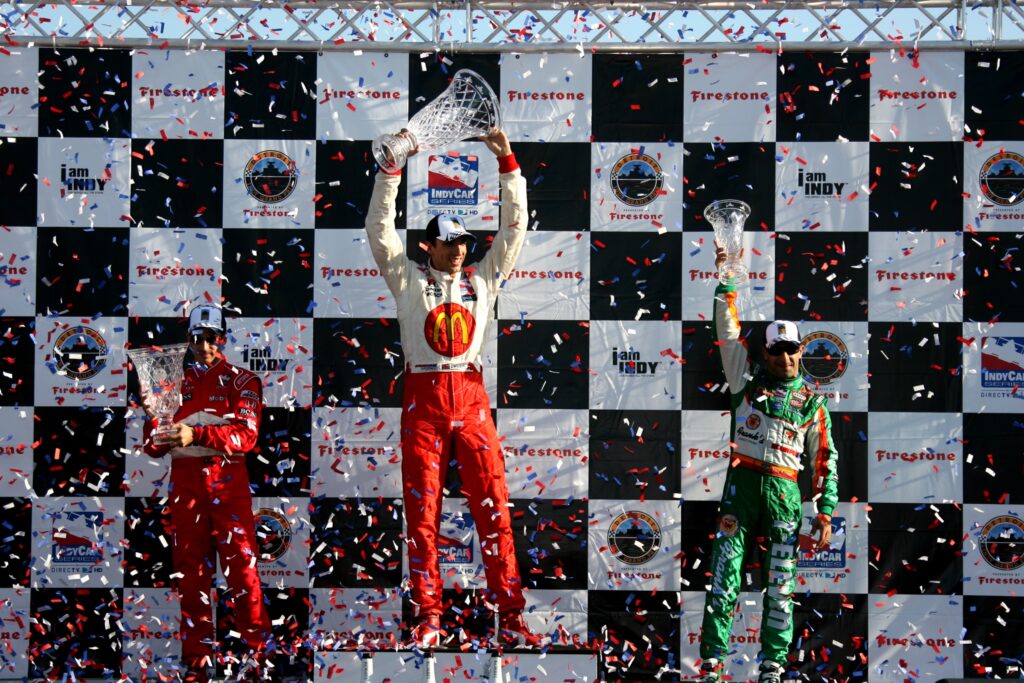
A: Probably not. It’s unrealistic to expect Champ Car teams, no matter how experienced or successful they may be, to be able to get as much out of the IRL’s Dallara-Honda package as IndyCar Series regulars. If any of the Champ Car transfers run consistently in the top ten in the first half of the season, it could be considered a success. Top five finishes would be a realistic achievement post-Indy.
[2020 note: Graham Rahal actually won the second race of the season, the St. Pete GP, in wet/dry conditions. It was Rahal’s debut in the IndyCar Series, having missed the opener at Homestead after he crashed in testing. Justin Wilson, also driving for Newman/Haas Racing, earned a win at Detroit Belle Isle in September, just a few weeks before team co-owner Paul Newman’s death]
Q: How will the merger affect Danica Patrick’s chances of winning a race?
A: Because additional quality teams and drivers are coming into the series, it will make Danica’s task tougher. However, if and when she does win a race, her achievement will be more significant since it will come against all the top drivers and teams in American open-wheel racing.
[2020 note: Danica crossed the line first in the last IRL race of the 1996-2008 split, at Twin Ring Motegi in Japan in April ‘08. She never won another race against the fully unified Indy car field, or in stock cars]
Q: How long will it take for the Champ Car drivers and teams to get up to speed?
A: Four to eight races is an educated guess. Since ovals haven’t been very common in the Champ Car series since 2002, that’s where they will struggle the most. The IRL is partnering Champ Car teams with IRL teams (for example, KV Racing will work with Target/Ganassi Racing) to speed up the learning curve.
[2020 note: Rahal’s win owed a lot to circumstances; Wilson outright won the 16th race of the season]
Q: Will some of the Champ Car drivers who have little or no oval racing experience pose a hazard to the IRL regulars?
A: Certainly none of them will be any more of a mobile chicane than Milka Duno was as a rookie in 2007. Yes, it will be a concern, and race officials Brian Barnhart and Tony Cotman will be monitoring their progress closely. But most of the drivers expected to compete are experienced enough to learn and adapt quickly.
[2020 note: It wasn’t a problem]
Q: Which Champ Car team is likely to be the most successful this year?
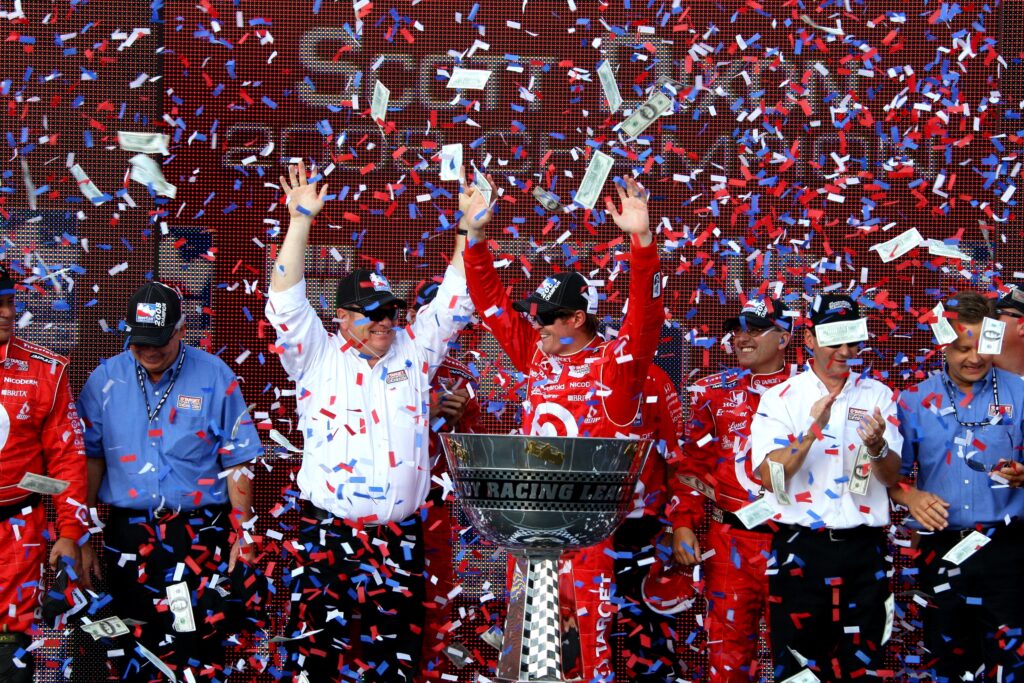
A: The obvious answer is Newman/Haas/Lanigan Racing. But Justin Wilson has run only a handful of Champ Car oval races, and Graham Rahal has competed on an oval just once – and that was in a Star Mazda car. KV Racing, the team operated by Kalkhoven and Jimmy Vasser, might stand the best chance if it fields cars for veterans Oriol Servia and Alex Tagliani.
[2020 note: Correct. Wilson and Rahal combined to win two races for Newman/Haas/Lanigan, but Oriol Servia and Will Power ran strongly for KV Racing. Servia was the highest Champ Car transfer in the standings, finishing ninth. Following Newman’s death, NHLR staggered, struggling to the extent that it prepared a car for Milka Duno to test in early 2009. The team finally disbanded in 2013 and Carl Haas died three years later. Mike Lanigan took his ownership stake to Rahal Letterman Racing. Besides Dale Coyne Racing, which continues to operate, KV Racing was the longest surviving Champ Car team, running through the end of 2016]
Q: What happens to the Champ Car Atlantic Championship?
A: Kalkhoven said he and Forsythe will continue to own and operate the single-seat training formula and will run a 12-race schedule this year.
[2020 note: After launching the career of Simona de Silvestro, who won three races, the Atlantic Championship was essentially shut down after the 2009 season]
Q: Will this unification help turn around open-wheel racing’s decline?
A: It certainly should, though IRL officials warn that there might not be an immediate effect on attendance or television ratings. But under IRL leadership, open-wheel racing has a solid foundation and in a best-case scenario, a measurable increase in popularity and awareness this year will lead to an influx of sponsors for 2009. A continued pattern of stability and growth would in turn attract manufacturer involvement when a new chassis/engine formula is introduced in 2010.
[2020 note: Indy car racing is in essentially the same place it was in 2008 in terms of popularity and public awareness. The sport did not receive the investment it needed in the immediate post-unification period, because the Hulman-George family was not in a strong financial position. Despite a move to the NBC family of networks, television ratings continue to decline. The silver lining is Indianapolis 500 attendance, which has rebounded strongly in the last ten years]
Q: Did Tony George win the war?
A: Yes.
[2020 note: But where is he now?]


